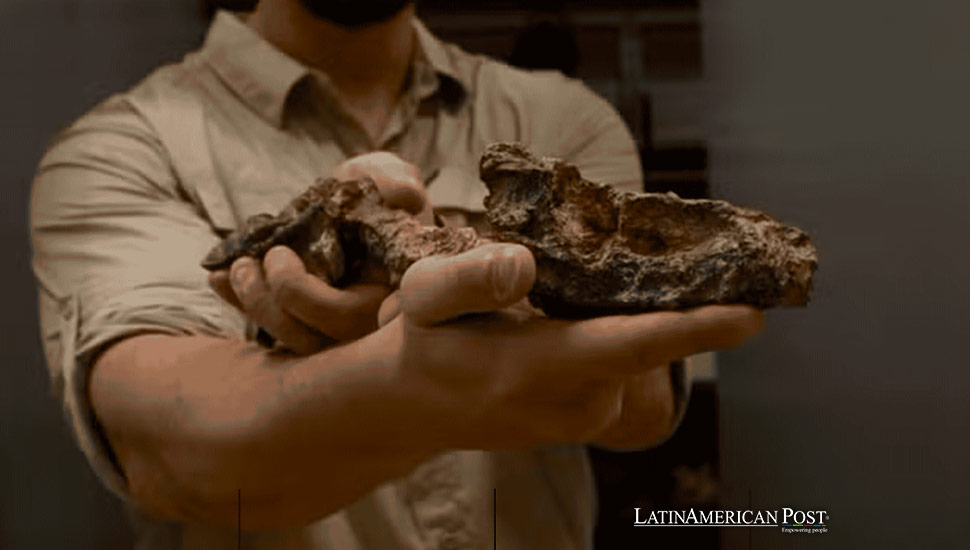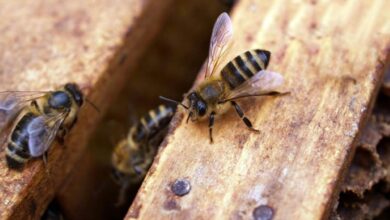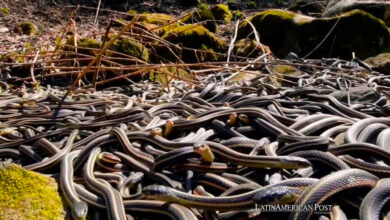Fossil Discovery in Brazil Uncovers Pre-Dinosaur Reptile

In a groundbreaking discovery, Brazilian scientist Rodrigo Muller identified fossils of Parvosuchus Aurelio, a small crocodile-like reptile that lived millions of years before the first dinosaurs, shedding light on the evolutionary history of reptiles.
In a remarkable discovery, a Brazilian scientist has identified fossils of a small crocodile-like reptile that lived during the Triassic Period, several million years before the first dinosaurs. The fossils of the predator, named Parvosuchus aurelioi, include a complete skull, 11 vertebrae, the pelvis, and some limb b. It preyedeontologist Rodrigo Muller of the Federal University of Santa Maria in Rio Grande do Sul state authored the research published on Thursday in the journal Scientific Reports.
Parvosuchus, which lived about 237 million years ago, walked on four legs and was approximately three feet (one meter) long. It preyed on smaller reptiles, and its fossils were unearthed in southern Brazil. Parvosuchus means “small crocodile,” it belonged to an extinct family of reptiles called the Gracilisuchidae, previously known only from Argentina and China.
The Significance of Parvosuchus
“The Gracilisuchidae are very rare organisms in the fossil world,” Muller told Reuters. “This group is exciting because they lived just before the dawn of the dinosaurs. The first dinosaurs lived 230 million years ago.”
Parvosuchus was a terrestrial predator. The Gracilisuchidae represents one of the earliest branches of a lineage known as Pseudosuchia, which later included the crocodile branch. The discovery of Parvosuchus in Brazil is significant as it provides new insights into the evolutionary history of reptiles in the region, highlighting the rich biodiversity that existed long before dinosaurs dominated the Earth.
Parvosuchus lived at a time of significant evolutionary innovation following Earth’s worst mass extinction 252 million years ago. This period saw multiple groups of reptiles competing for dominance, setting the stage for the eventual rise of dinosaurs. The last undisputed members of the Gracilisuchidae died out about seven million years before the first dinosaurs appeared.
The discovery of Parvosuchus in Brazil adds a crucial piece to the puzzle of prehistoric life in Latin America. During the Triassic Period, South America was part of the supercontinent Pangaea, providing a unique environment for the evolution of early reptiles. The fossil record from this time is sparse, making each new find incredibly valuable for understanding the continent’s prehistoric ecosystems.
Muller’s discovery underscores the pivotal role of South America in paleontological research. The region has been a treasure trove of fossils that have helped scientists piece together the evolutionary history of reptiles. From the discovery of early dinosaurs in Argentina to the unearthing of giant prehistoric crocodiles in Brazil, Latin America remains a vibrant hub for paleontological discoveries.
This discovery also illuminates the collaborative spirit of paleontological research in Latin America. Scientists from across the continent unite to uncover and study fossils, sharing knowledge and resources. This collective effort has led to significant discoveries that have advanced our understanding of prehistoric life in Latin America and worldwide.
A Glimpse into Pre-Dinosaur Ecosystems
Parvosuchus lived in an era of rapid evolutionary changes and competition among various reptile groups. The early Triassic Period was a time of recovery and diversification following the Permian-Triassic extinction event, which wiped out approximately 90% of marine species and 70% of terrestrial vertebrates. In this new world, reptiles began to explore and exploit new ecological niches, leading to a burst of evolutionary activity.
The discovery of Parvosuchus offers a glimpse into this dynamic period. As a small terrestrial predator, Parvosuchus would have played a pivotal role in its ecosystem, helping to maintain the delicate balance of prey and predator species. Its coexistence with other early reptiles paints a vivid picture of the intricate web of interactions that characterized Triassic ecosystems.
The fossils of Parvosuchus also provide valuable information about the anatomy and behavior of early reptiles. The well-preserved skull and vertebrae allow scientists to study its feeding habits, locomotion, and sensory capabilities. This detailed anatomical knowledge helps paleontologists reconstruct the life and environment of these ancient animals, offering a glimpse into a world long gone.
The discovery of Parvosuchus has important implications for future paleontological research in Brazil and beyond. It highlights the potential for finding more early reptile fossils in South America, encouraging further exploration and excavation in the region. Each new find adds to our understanding of the diversity and distribution of prehistoric life, providing a more complete picture of Earth’s evolutionary history.
Moreover, studying Parvosuchus and other early reptiles can shed light on the broader patterns of evolution and extinction. By examining how these animals adapted to their environments and responded to changing conditions, scientists can gain insights into the processes that drive evolutionary change. This knowledge is essential for understanding the past and predicting how modern species might respond to current and future environmental challenges.
The discovery of Parvosuchus underscores the ongoing need for sustained support and funding for paleontological research. Fossil hunting and analysis are resource-intensive endeavors that demand significant investment. By supporting scientific research in this field, we can foster groundbreaking discoveries that enrich our understanding of the natural world and inspire future generations of scientists.
A Landmark Discovery
The identification of Parvosuchus aurelioi is a landmark discovery in paleontology. It sheds light on a critical period in Earth’s history and provides new insights into the early evolution of reptiles. This discovery highlights Brazil and Latin America’s rich fossil heritage and underscores the importance of international collaboration in scientific research.
As scientists continue to uncover the secrets of the past, discoveries like Parvosuchus remind us of the incredible diversity of life on our planet. Each fossil tells a story, adding to the tapestry of Earth’s history and deepening our understanding of the forces that have shaped life on this planet.
Also read: Academic Censorship in Brazil is A Covert Attack on Right-Wing Free Speech
In the years to come, continued research and exploration in Latin America will undoubtedly lead to more exciting discoveries, further illuminating the ancient world and enhancing our appreciation of the natural history of this remarkable continent. The story of Parvosuchus is just one chapter in a much larger narrative that continues to unfold with each new fossil unearthed.





